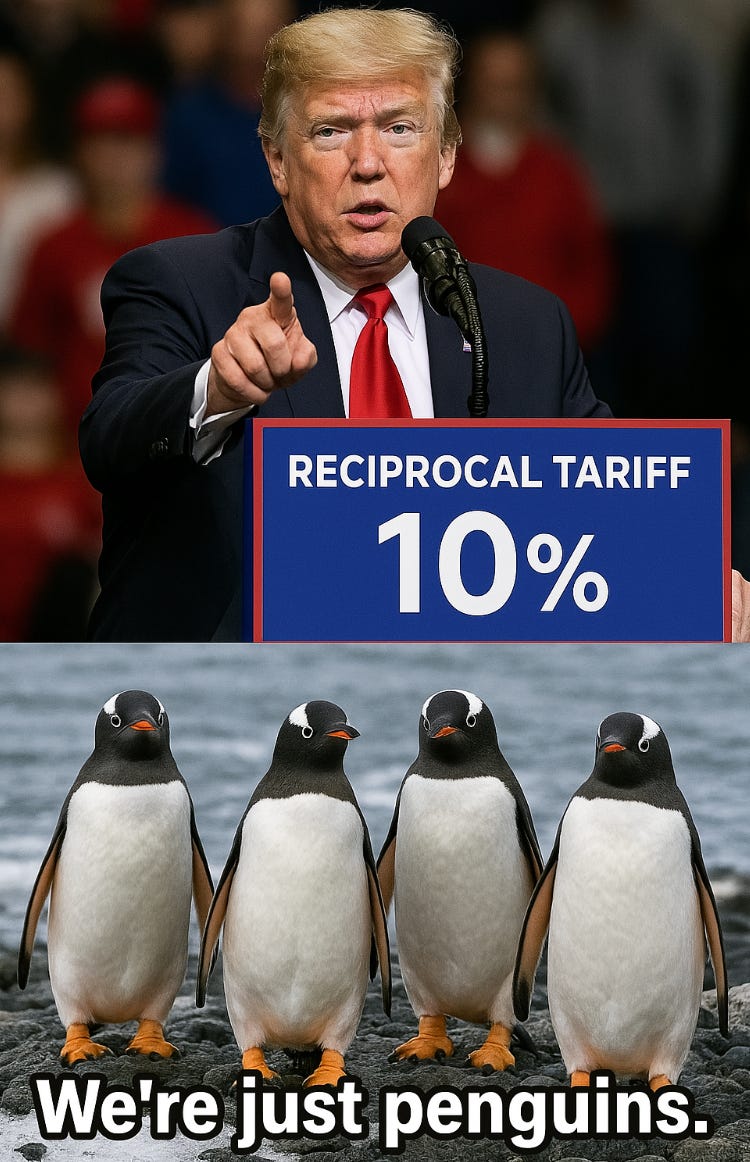
[This is a heavily censored version of our Market Review, due to the sensitive nature of our opinions. To access the full, uncensored edition, please visit our Substack.]
When Trump announced the “reciprocal tariff” on April 2—Liberation Day—our attention was focused on the nearly 400-page document titled Foreign Trade Barriers. Few actually discussed the content of the report, as most people chose instead to mock the seemingly absurd concept of a “reciprocal tariff.”
And absurd it is. The numbers presented don’t even reflect the actual tariffs imposed by other countries on the U.S., but rather the U.S. trade deficit with each of those countries. The inclusion of a tiny, uninhabited island—home only to penguins (Heard Island and McDonald Islands)—as a target for U.S. tariffs made the announcement even more laughable, prompting widespread ridicule of Trump.
But within the thick document, we see not only the unfair trade practices of many countries toward the U.S., but also …
… [redacted parts]
Perhaps this is Trump’s way of trying to fix the mess: using a controversial and unconventional approach. Sometimes, fixing things requires starting from scratch and doing the unthinkable. And in the process, the rest of the world might benefit too—through reduced trade restrictions and a better business environment for local communities.
US-China Trade War
As days progressed, it became clear that the main tariff target is China. So far, no other country has retaliated against the seemingly absurd U.S. tariffs—except China and the EU. The EU's $26 billion retaliation appears more political—aimed at helping EU leaders save face domestically—than a real countermeasure. So far, only China and Canada has responded seriously. As of today, the U.S. has imposed a 125% tariff on Chinese goods, while China has imposed an 84% tariff on U.S. imports.
This feels like a continuation of the first U.S.-China trade war that began in 2018—only this time, Trump is making bolder moves. By involving the rest of the world with his seemingly absurd 'reciprocal tariffs,' the U.S. could secure better deals elsewhere, thereby reducing the pain from the trade war with China. So far, it seems to be working—at least based on what we’re seeing in the news. Many countries are sending trade delegations to the U.S. for negotiations.
So who will win the trade war? Ideally, the best outcome is for everyone to reach good deals. But if it comes down to a “fight to the end”—as China has suggested—the U.S. has a much greater capacity to endure the impact than China. The U.S. is far more self-sufficient, especially when it comes to the basics. At the very least, the U.S. is independent in food production, whereas China is not.
For example, China consumed 122 million metric tons (MMT) of soybeans in 2024. Of that total, 75 MMT were imported from Brazil, 22 MMT from the U.S., and 4 MMT from Argentina. China uses soybeans primarily for pork and poultry feed. Note that the U.S. and Brazil effectively form a duopoly in global soybean production. If the U.S. were to halt soybean exports to China, Brazil would struggle to fill the gap on its own.
Pain Tolerance
But the capacity to bear the brunt isn’t what determines who wins—it’s the pain tolerance that matters most. And in this case, China appears to have a higher pain threshold than the U.S.
Only 30 years ago, China was still a poor country—just one generation removed from widespread hardship. Many of today’s Chinese leaders lived through that era and remember it firsthand. More importantly, the Chinese government maintains strict control over its population, not just to manage crises, but to keep its citizens in check. This level of control allows the government to suppress unrest, control narratives, and enforce compliance during tough times—giving China a unique advantage in weathering prolonged economic stress.
In contrast, the U.S. has enjoyed wealth and relative comfort for over a century. The last Great Depression was more than 90 years ago. Today, a mere 15% drop in the S&P 500 can cause widespread panic, and a doubling of gas prices can swing an election. (During Biden’s presidency, gas prices doubled, and the Democratic Party lost the 2024 election to the Republicans and Trump.)
It’s hard to quantify, but the U.S. clearly has a lower national pain tolerance. And politically, its leaders have only four years to deliver results—or face replacement. China’s leadership, in comparison, remains indefinitely in power.
Given this background, it’s understandable why Trump has made such bold—some would say reckless—moves at the start of his presidency. His time is limited, and he must act decisively while he still has the full backing of his supporters.
To make matters worse for Trump, his time isn’t even a full four years. The U.S. will hold midterm elections in November 2026, just two years into his term. If he makes a serious mistake or loses public support, he could lose the midterms—handing over control of the Senate, the House, or even both to the opposition. That would severely limit his ability to act for the remainder of his presidency.
Can Trump Succeed
We understand that most people mock him now. He makes people think he is mockable.
However, we should note that he still has two arsenals up his sleeve: deregulation policies and tax cut programs. Together with the seemingly absurd tariff strategy, these could actually achieve what Trump’s mandate aims for: bringing more business to the U.S., reducing inflation, and lowering income tax—all while the U.S. dollar remains the world’s reserve currency.
So far, these two programs have not received much attention because people are focused on the tariffs. But we may see them come into play later this year.
Portfolio Strategy [redacted]
Given this background, we believe all this volatility should pass within this year or next, before the midterm election. In the meantime, it will be a harsh environment for the stock market.
…
We still believe stock picking becomes more important than a top-down approach in this high-volatility environment.
…
…it’s that most of them are U.S.-centric businesses—which fortunately aligns with our view that the U.S. will come out ahead after this tariff debacle.
…
…we believe the U.S. remains the best place to invest—and that dollar-cost averaging is still the most optimal way to build long-term wealth.
Disclaimer:
“Market Review by Christmas Corp” is provided for informational and educational purposes only. Nothing contained in this publication should be considered as investment advice, recommendations, or guarantees of future performance. While we strive for accuracy, Christmas Corp makes no warranties regarding the reliability or completeness of the information. Investing in financial markets carries risk, including potential loss of principal. Readers should conduct their own due diligence and seek professional financial guidance before making investment decisions. Christmas Corp and its affiliates assume no liability for any losses arising from the use of this content.








